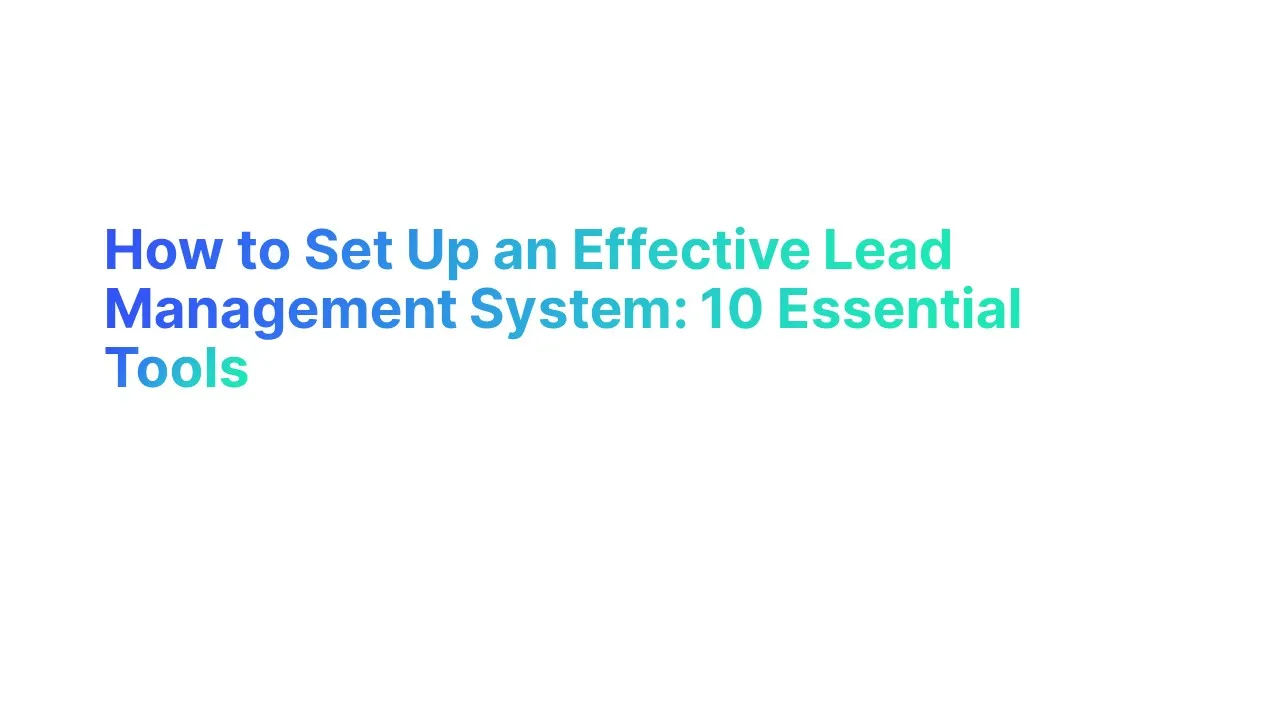Introduction to Lead Management

What is Lead Management
Lead management is a systematic process used by marketing and sales teams to identify, track, and manage potential customer interactions and data throughout the sales cycle. The goal of lead management is to enhance the efficiency of sales operations and increase conversion rates by organizing leads based on their probability of becoming customers.
For example, a company like HubSpot uses lead management software to segment leads based on their behaviors and interactions with the website. This segmentation allows the sales team to tailor communications and offers, significantly improving the chances of converting leads into actual customers. Such a focused approach demonstrates how effective lead management can directly contribute to a company's revenue growth.
Lead Management Process

The lead management process is a critical component of a company's sales and marketing strategy. It involves several key steps designed to convert prospects into loyal customers by effectively managing and nurturing leads throughout the sales funnel. This structured approach not only increases the chances of conversion but also optimizes the marketing and sales teams' efforts, ensuring that resources are used most efficiently.
Key Steps in the Lead Management Process:
Lead Capturing
- The first step involves collecting information about potential customers from various sources such as website forms, social media, direct mail campaigns, or trade shows.
- Effective capturing often uses management software to automate data entry and ensure all lead data is centralized.
Lead Tracking
- Once leads are captured, tracking their behavior and engagement becomes crucial. This includes monitoring website visits, email interactions, and social media engagement.
- Tools like lead management systems can automate the tracking process, providing real-time data that can inform further strategy.
Lead Qualification
- Not every lead is a potential customer. Lead qualification separates viable leads from those less likely to convert, using criteria such as lead scoring based on their activities and engagement level.
- Statistics show that nurtured leads produce, on average, a 20% increase in sales opportunities compared to non-nurtured leads.
Lead Distribution
- Qualified leads are then distributed to the appropriate sales team or sales rep. This distribution is often based on specific territories, industries, or product expertise to maximize the chances of conversion.
- A well-implemented distribution strategy can increase conversion rates by up to 40% by aligning leads with the most suitable sales personnel.
Lead Nurturing
- This involves engaging with the leads through various marketing channels to keep them interested and move them further along the sales funnel.
- Emails, personalized content, and targeted offers are typical nurturing techniques. Studies indicate that companies that excel at lead nurturing generate 50% more sales-ready leads at a 33% lower cost.
Lead Conversion
- The final stage is converting a nurtured lead into a customer. This step requires close coordination between sales and marketing to ensure that the lead receives all the necessary information and motivation to make a purchase.
- Effective lead management systems report a higher conversion rate, with some businesses seeing an increase of up to 300% in conversion effectiveness.
How to Set up an Effective Lead Management System

Setting up an effective lead management system is crucial for streamlining sales and marketing efforts, ensuring that potential customers are efficiently converted into actual customers.
An optimized system facilitates improved tracking, management, and nurturing of leads, significantly boosting conversion rates and overall business growth.
Steps to Set Up an Effective Lead Management System:
1. Choosing the Right Lead Management Software:
- Selection Criteria: Evaluate lead management software based on features such as lead capture, tracking, qualification, and integration capabilities with existing CRM systems.
- Popular Tools: Consider popular solutions like HubSpot, Salesforce, and Zoho, which are known for their robust features and scalability. These tools often show a direct correlation with improved lead management efficiency, with businesses reporting up to a 30% increase in conversion rates when using advanced lead management features.
2. Integration with Existing Tools:
- Seamless Integration: Ensure that the lead management system integrates seamlessly with existing marketing and sales tools such as email marketing software, social media platforms, and customer data platforms.
- Data Synchronization: Integration helps in real-time data synchronization, which is vital for maintaining accurate and up-to-date lead information. Statistics show that companies with integrated lead management systems reduce lead leakage by up to 10%.
3. Configuring Lead Capture and Tracking:
- Capture Mechanisms: Set up multiple lead capture mechanisms across all digital touchpoints, including websites, social media, and email campaigns.
- Automated Tracking: Utilize the software to automatically track lead interactions such as website visits, email opens, and downloads. Companies using automated tracking report an average increase in lead volume by 15%.
4. Setting Up Lead Qualification Parameters:
- Define Criteria: Establish clear lead qualification criteria based on demographics, behavior, and engagement. Use scoring models to prioritize leads that are more likely to convert.
- Dynamic Scoring: Implement dynamic lead scoring that adjusts scores based on evolving lead behavior and interaction data. Research indicates that dynamic scoring improves lead qualification accuracy by 20%.
5. Lead Distribution Strategy:
- Distribution Rules: Create rules for distributing qualified leads among sales teams or representatives based on geographic location, product expertise, or industry knowledge.
- Automated Distribution: Automate the distribution process to ensure leads are quickly assigned to the appropriate sales rep, reducing response time and increasing the likelihood of conversion by up to 35%.
6. Developing a Lead Nurturing Strategy:
- Multichannel Nurturing: Develop nurturing campaigns using a mix of email, social media, and personalized content to engage leads at various stages of the funnel.
- Content Personalization: Tailor content based on the specific interests and past behaviors of leads. Studies show that personalized email campaigns can lift conversion rates by as much as 10%.
7. Monitoring and Analysis:
- Performance Metrics: Regularly monitor key performance indicators such as lead conversion rates, campaign effectiveness, and ROI from each lead source.
- Continuous Improvement: Use analytics to continuously refine and optimize the lead management process. Businesses that regularly analyze lead management data see a 25% increase in marketing effectiveness.
10 Lead Management Software

Choosing the right lead management software can dramatically enhance the efficiency of your sales and marketing operations. Here are five of the best lead management software options available today, each with its own unique strengths and features:
1. HubSpot CRM
Overview: HubSpot CRM is renowned for its comprehensive integration of sales, marketing, and customer service tools, offering a seamless lead management experience.
Key Features:
- Automated lead capture from multiple channels.
- Detailed lead tracking and nurturing workflows.
- Built-in analytics for measuring performance and ROI.
- Easy integration with other HubSpot marketing tools.
Benefits:
- Free to start with scalable premium options, making it ideal for businesses of all sizes.
- User-friendly interface that requires minimal training.
Ideal for: SMBs to large enterprises looking for a full-suite CRM that grows with their needs.
2. Salesforce Sales Cloud
Overview: Salesforce is one of the most powerful and customizable lead management solutions, offering extensive features for companies with complex sales processes.
Key Features:
- Highly customizable lead scoring and grading systems.
- Advanced reporting and forecasting tools.
- Extensive marketplace of add-ons and integrations via Salesforce AppExchange.
Benefits:
- Robust automation capabilities for large sales teams.
- Strong mobile functionality to manage leads on the go.
Ideal for: Large enterprises or businesses with specialized sales processes requiring extensive customization.
3. Zoho CRM
Overview: Zoho CRM is a cost-effective solution for small to medium-sized businesses, offering a good balance of features and simplicity.
Key Features:
- Lead scoring, tracking, and segmentation tools.
- Multi-channel communication allows for integration with email, live chat, and social media.
- Artificial intelligence assistant, Zia, for sales predictions and suggestions.
Benefits:
- Affordable pricing with a variety of packages to suit different needs.
- Extensive automation capabilities to streamline lead management tasks.
Ideal for: SMEs that need an affordable CRM with robust automation and multi-channel support.
4. Pipedrive
Overview: Pipedrive is designed with sales teams in mind, focusing on activities that drive deals to close and simplifying the sales process.
Key Features:
- Visual sales pipeline management.
- Customizable activity and goal tracking.
- Automation of repetitive administrative tasks.
Benefits:
- Intuitive interface that visualizes your sales pipeline.
- Strong focus on usability and efficiency.
Ideal for: Sales-focused organizations that benefit from visualizing their pipeline and emphasizing sales actions.
5. Freshworks CRM
Overview: Freshworks CRM (formerly Freshsales) is known for its user-friendly interface and powerful sales automation features.
Key Features:
- AI-based lead scoring, email tracking, and auto-profile enrichment.
- Integrated phone and email, with templates and tracking.
- Comprehensive analytics for sales insights and forecasting.
Benefits:
- Combines simplicity with powerful sales automation.
- Offers a fully integrated system with Freshdesk for customer support.
Ideal for: Businesses that need a straightforward yet powerful CRM that integrates closely with customer support functions.
6. Microsoft Dynamics 365 for Sales
Overview: Microsoft Dynamics 365 for Sales is a comprehensive customer relationship management platform that integrates deeply with other Microsoft products, enhancing productivity and customer relationships.
Key Features:
- Seamless integration with Microsoft Office tools and Outlook.
- Advanced analytics powered by AI, offering insights and predictive information about lead generation and sales qualified leads.
- Customizable workflows and automation capabilities.
Benefits:
- Ideal for businesses already entrenched in the Microsoft ecosystem.
- Offers strong customization options and robust data security, making it one of the right lead management tools for large enterprises.
Ideal for: Enterprises looking for a CRM that integrates well with other enterprise solutions like ERP systems and familiar Microsoft products.
7. Insightly
Overview: Insightly is a CRM and project management tool in one, offering unique features that help manage everything from lead acquisition to the successful closure of deals, emphasizing customer relationship management.
Key Features:
- Project management features integrated with CRM functionalities.
- Relationship linking between contacts, organizations, and projects.
- Mobile app with business card scanner for real-time lead generation.
Benefits:
- Combines customer relationship management with project oversight.
- Intuitive user interface and integration with popular apps like G Suite, Office 365, and Slack.
Ideal for: Small to medium-sized businesses that need both CRM and project management in one platform.
8. Act!
Overview: Act! offers a blend of CRM and marketing automation that is particularly suited to small and midsize businesses looking to grow their customer base through effective lead generation.
Key Features:
- Comprehensive contact management with detailed histories.
- Marketing automation for campaigns across multiple channels, targeting sales qualified leads.
- Customizable dashboards and reports.
Benefits:
- User-friendly with a strong focus on marketing automation features.
- Flexible deployment options including cloud, on-premises, and hybrid, making it one of the right lead management tools for diverse business models.
Ideal for: SMBs that need strong marketing tools integrated with their CRM.
9. Copper (formerly ProsperWorks)
Overview: Copper is known for its deep integration with Google Workspace, making it a seamless choice for organizations using Google applications to manage customer relationships.
Key Features:
- Automatic data entry with a zero-input data system.
- Close integration with Google Workspace apps.
- Visual pipeline management tools, perfect for tracking lead generation and sales qualified leads.
Benefits:
- Highly intuitive for Google users, reducing the learning curve.
- Strong focus on eliminating manual data entry.
Ideal for: Businesses looking for a CRM that works hand-in-hand with Google Workspace to minimize administrative tasks.
10. Nimble
Overview: Nimble is a simple yet effective CRM for Office 365 and G Suite users, focusing on building stronger customer relationships through enhanced social media engagement.
Key Features:
- Unified contact database that gathers data from online sources, boosting lead generation.
- Social media integration and insights to identify sales qualified leads.
- Easy contact segmentation and group messaging.
Benefits:
- Provides a 360-degree view of customers by combining CRM features with social media.
- User-friendly and effective for teams that prioritize social media engagement, making it one of the right lead management tools for digital-focused strategies.
Ideal for: Small businesses and professionals who need a straightforward, social media-focused CRM.
Best Lead Management Techniques
Effective lead management is crucial for optimizing the sales pipeline and improving conversion rates. Here are some of the best techniques to manage leads efficiently, ensuring a streamlined process from initial contact to successful conversion:
1. Implement a CRM System
- Purpose: Centralize all lead information to improve accessibility and tracking.
- Benefits: A CRM system helps organize and automate the management of customer data, making it easier for sales teams to track interactions and history.
2. Lead Scoring
- Purpose: Prioritize leads based on their likelihood to convert.
- Technique: Assign scores to leads based on predetermined criteria such as engagement level, demographic information, and behavior on your site.
- Benefits: Increases efficiency by allowing sales teams to focus on leads that are most likely to convert, thereby optimizing resource allocation.
3. Lead Segmentation
- Purpose: Categorize leads into distinct groups for targeted marketing strategies.
- Technique: Segment leads based on various factors like industry, company size, or pain points.
- Benefits: Tailored marketing messages improve response rates and engagement, leading to higher conversion rates.
4. Nurturing Campaigns
- Purpose: Keep leads engaged throughout the buying process.
- Technique: Use automated email marketing, personalized content, and regular follow-ups to maintain contact and provide valuable information.
- Benefits: Helps in building relationships and trust with potential customers, which can significantly increase the chances of a sale.
5. Rapid Response Time
- Purpose: Improve lead conversion rates through timely responses.
- Technique: Implement processes or automated tools that ensure quick follow-up on new leads.
- Benefits: Studies show that responding within an hour of receiving a query can make you nearly 7x more likely to qualify the lead (i.e., have a meaningful conversation with a decision-maker) compared to waiting even an hour longer.
6. Use of Analytics and Reporting
- Purpose: Continuously improve lead management strategies.
- Technique: Regularly analyze the data collected from various interactions with leads to identify patterns, trends, and areas for improvement.
- Benefits: Enables businesses to refine their lead management process, marketing strategies, and sales tactics based on concrete data, increasing overall efficiency and effectiveness.
7. Integration of Sales and Marketing
- Purpose: Ensure a seamless transition of leads from marketing to sales.
- Technique: Maintain open communication channels and regular meetings between the two teams to ensure alignment on goals and strategies.
- Benefits: Reduces lead leakage and increases conversion rates by ensuring that leads are nurtured and followed up on at the right stages.
8. Social Media Engagement
- Purpose: Engage leads where they spend a significant amount of time.
- Technique: Use social media platforms to interact with potential customers, answer questions, and post content that leads them back to your site.
- Benefits: Enhances brand visibility and engagement, allowing for more personalized interaction with potential leads.
Closing Thoughts for Sales and Marketing Teams Looking to Effectively Manage Leads
In conclusion, setting up an effective lead management system encompasses choosing the right tools, integrating seamlessly with existing technologies, and deploying strategies that optimize each stage of the lead management process. From capturing and tracking to qualifying and nurturing, each step is crucial for converting prospects into sales-qualified leads.
Implementing these strategies not only streamlines your sales and marketing efforts but also significantly enhances your ability to nurture each lead into a sales-qualified lead, ultimately boosting overall conversion rates and driving business growth. This comprehensive approach ensures that your team is equipped to handle leads effectively, turning potential opportunities into valuable customer relationships.





.jpg)

.jpg)
